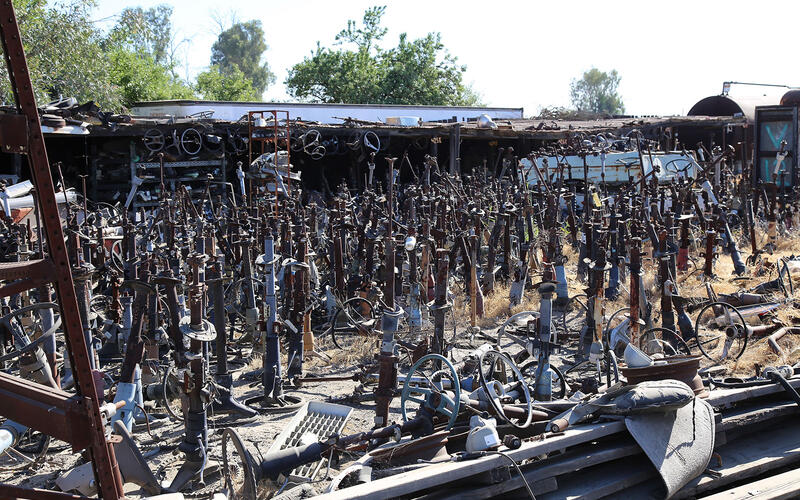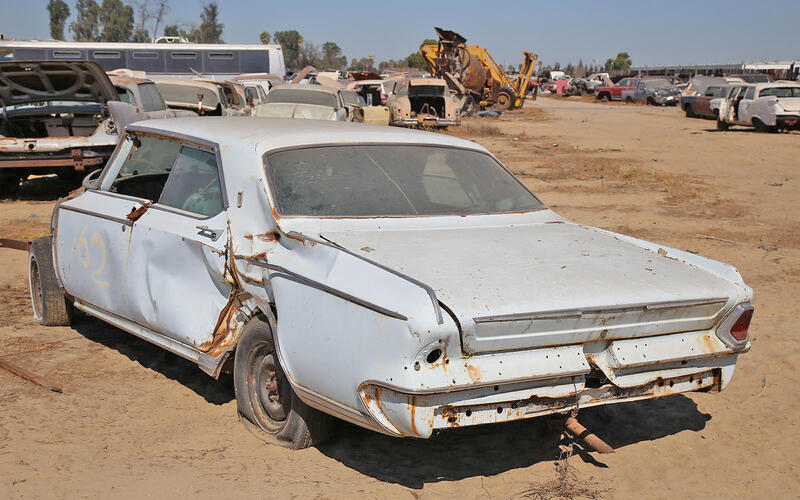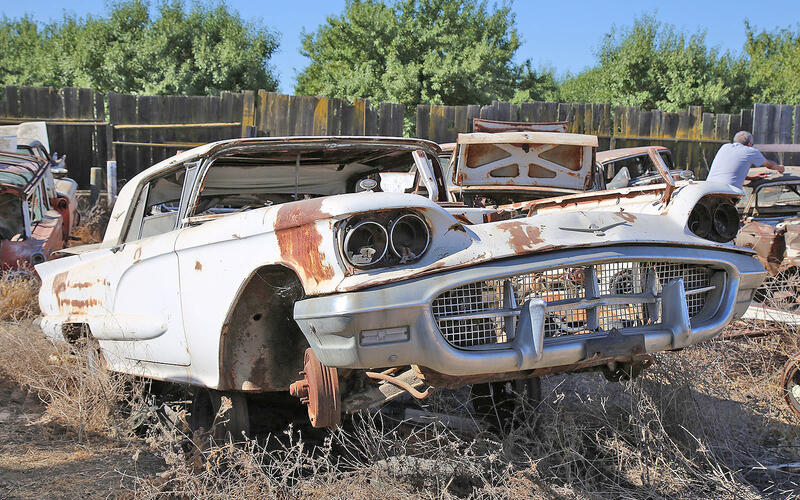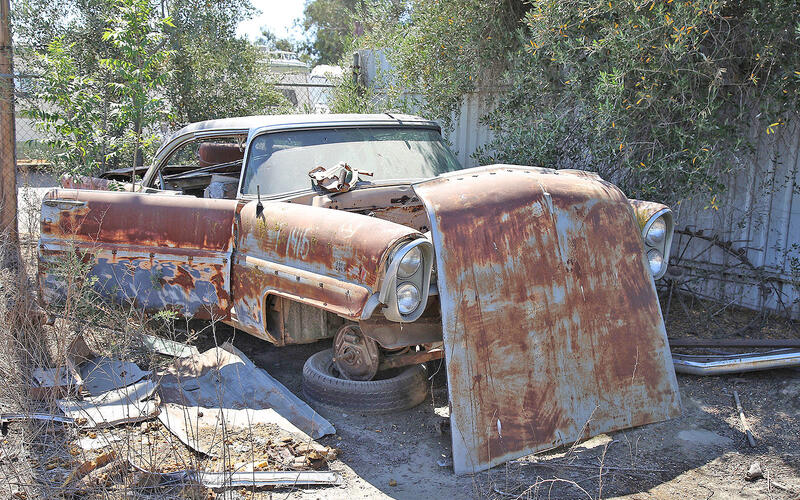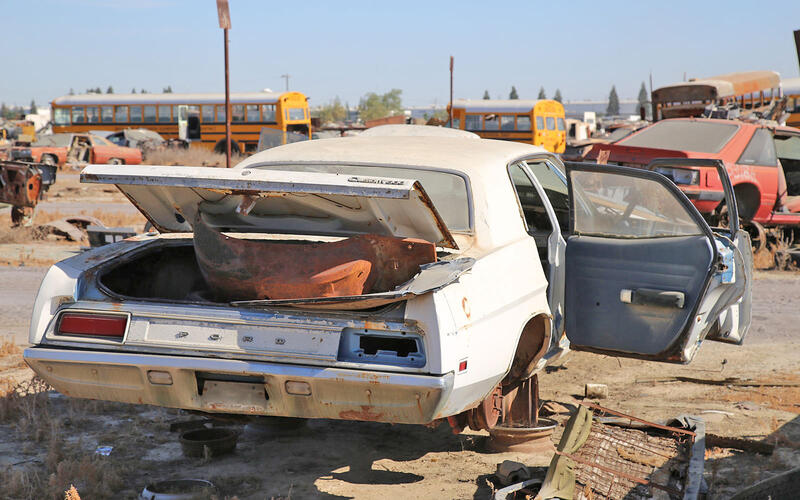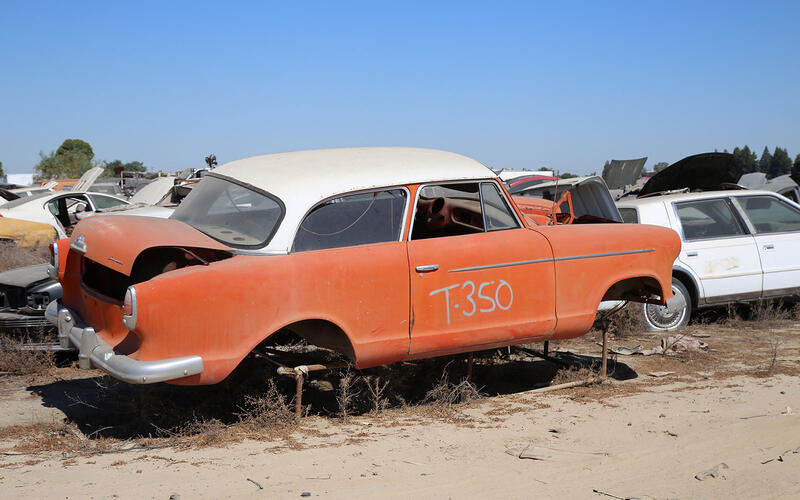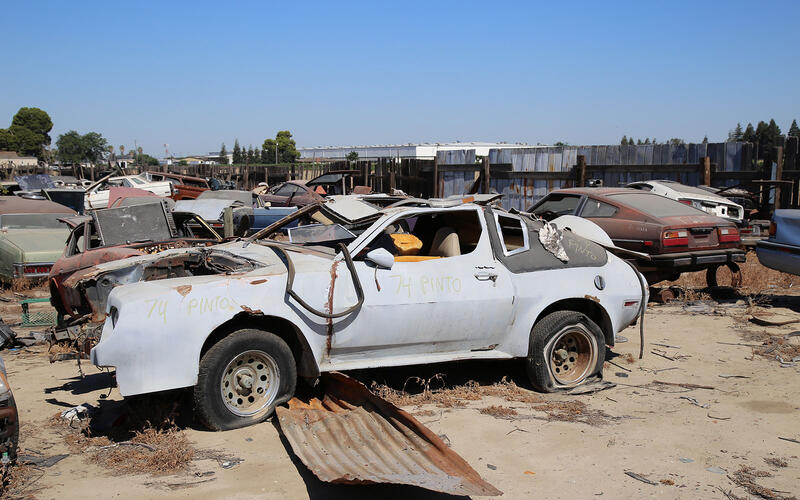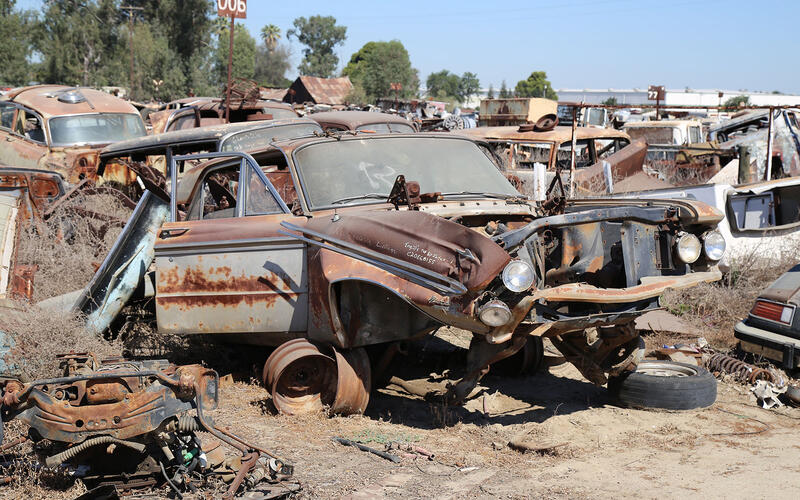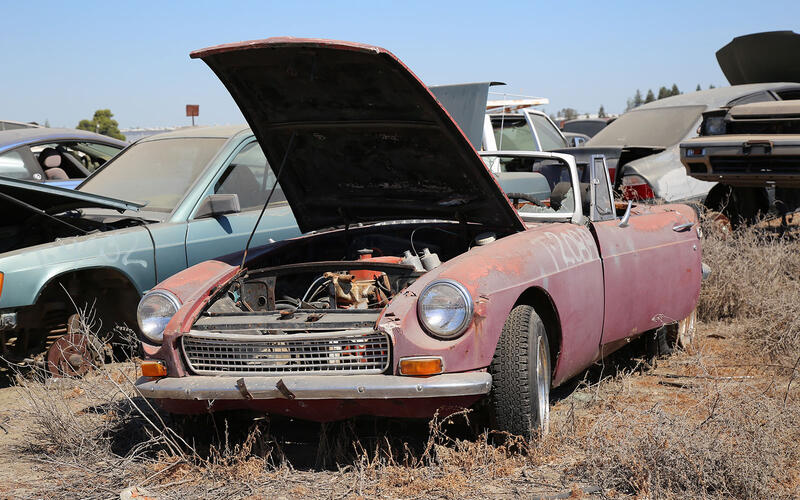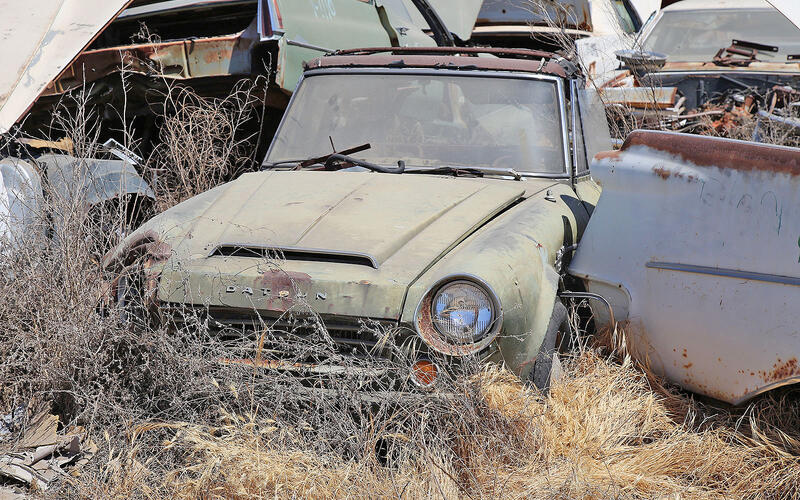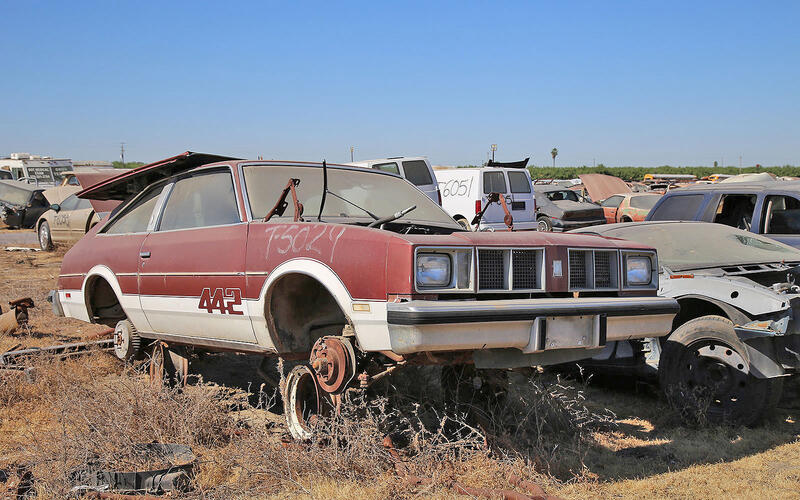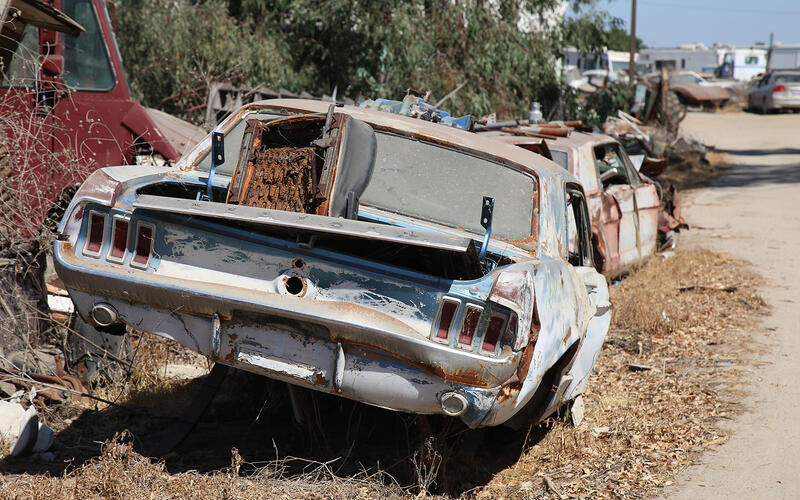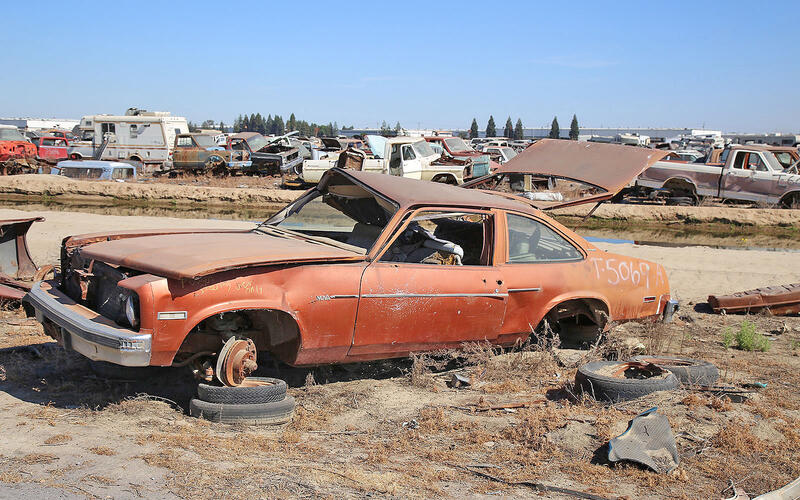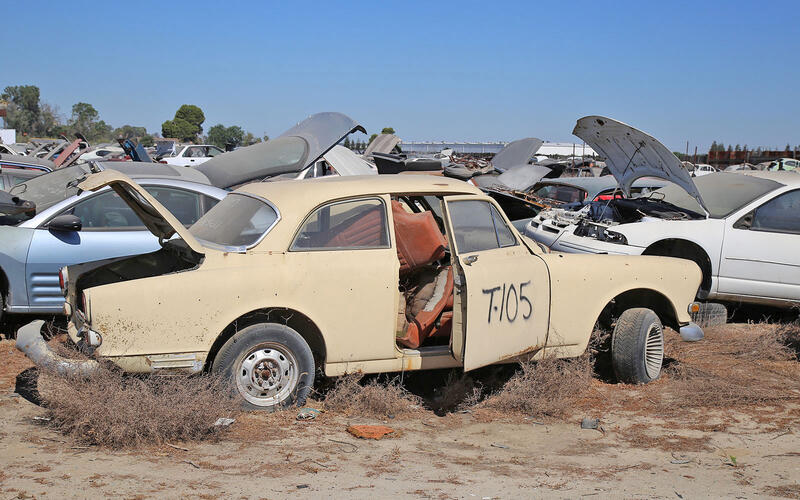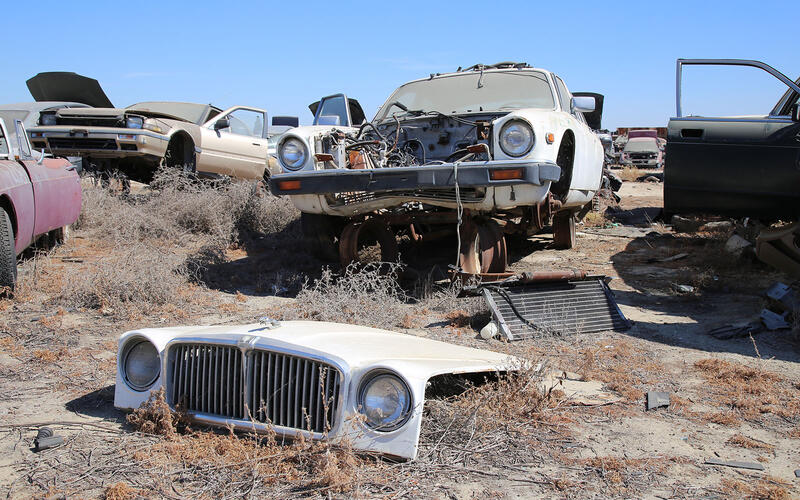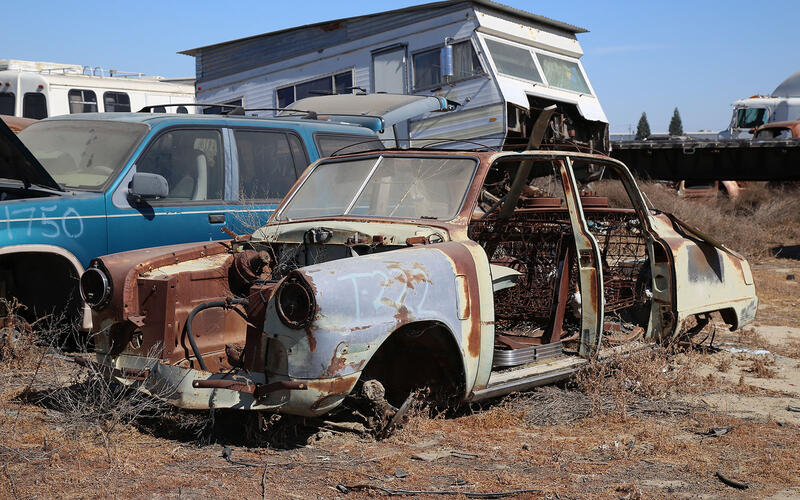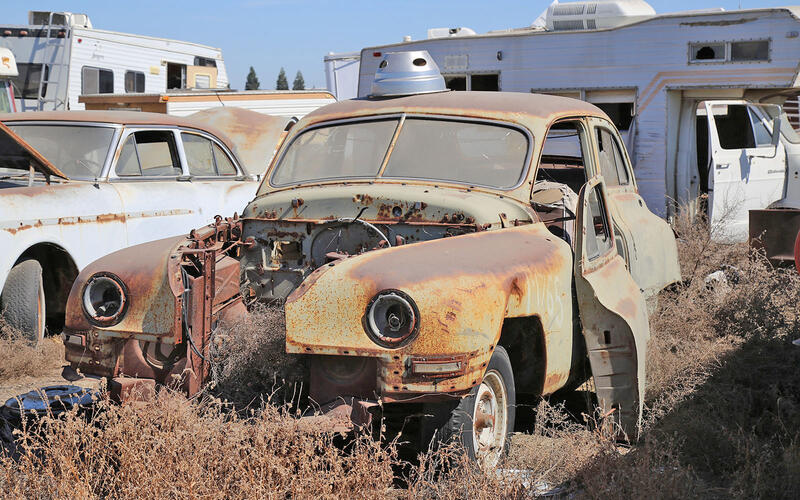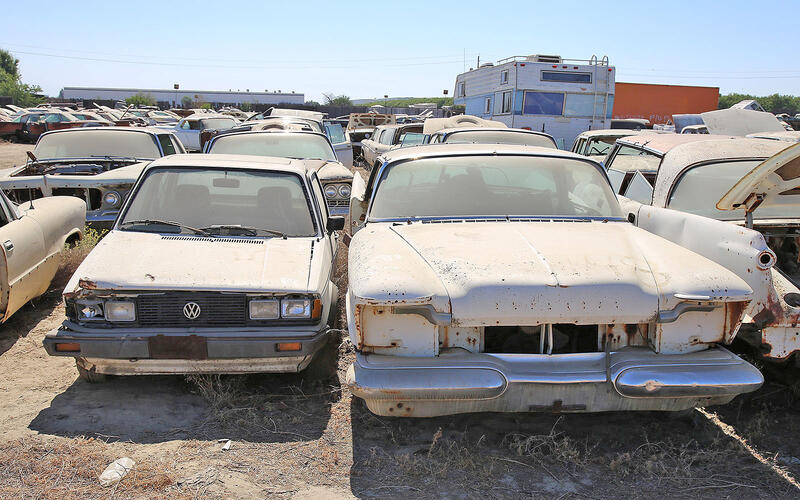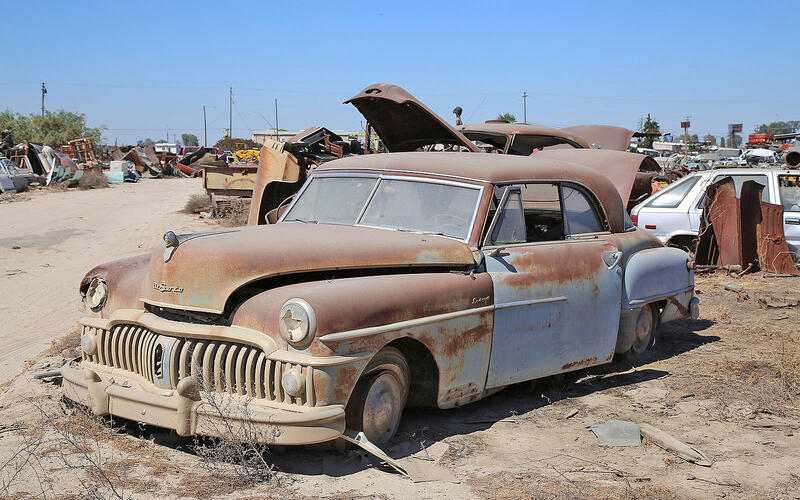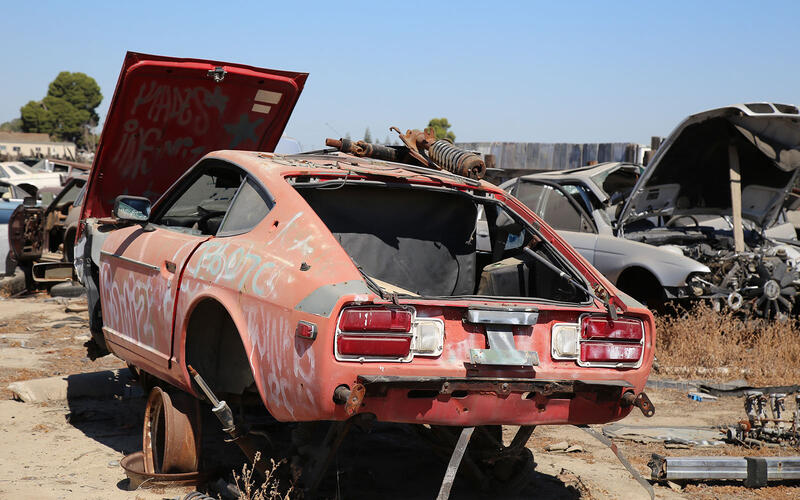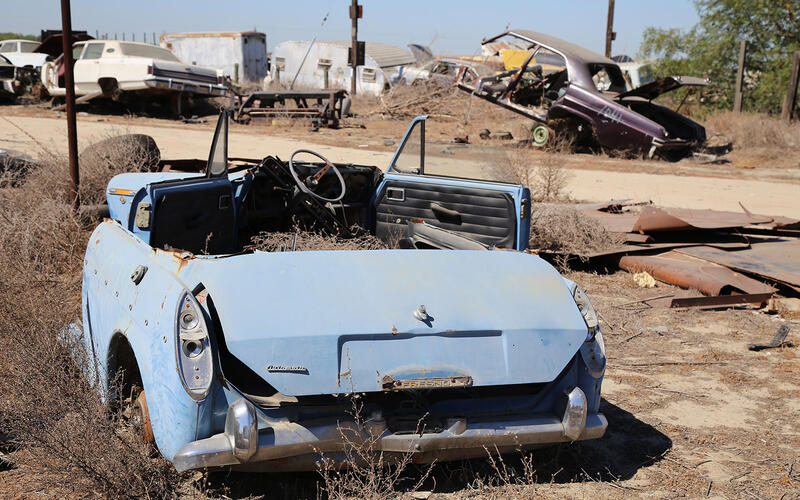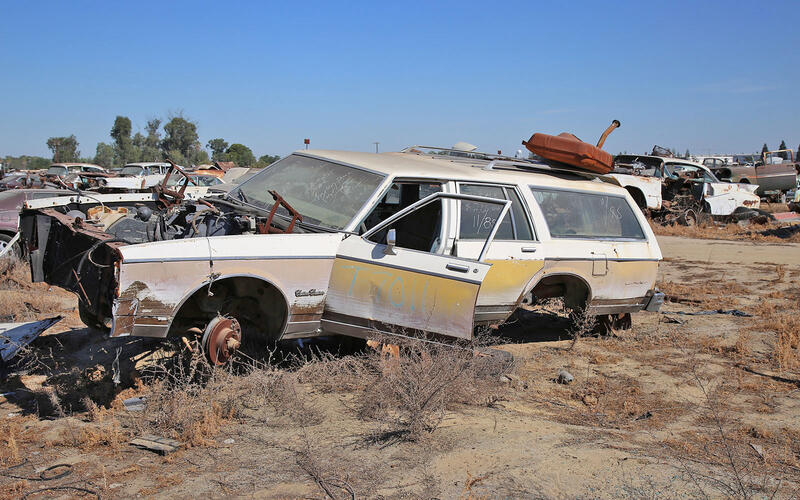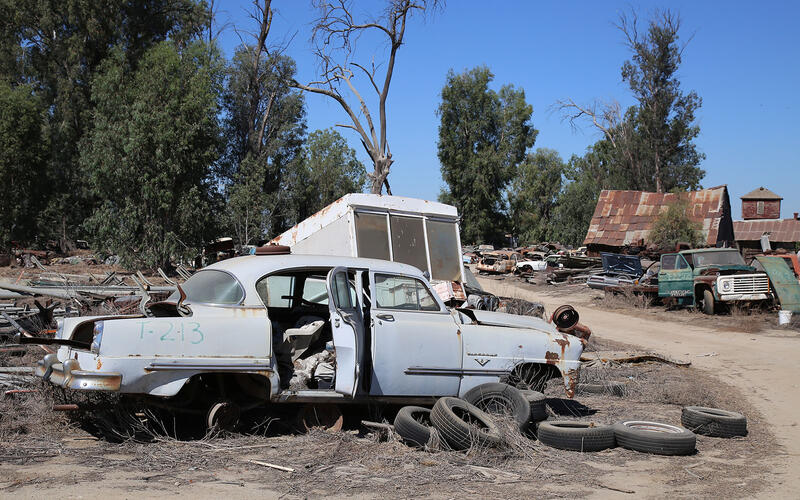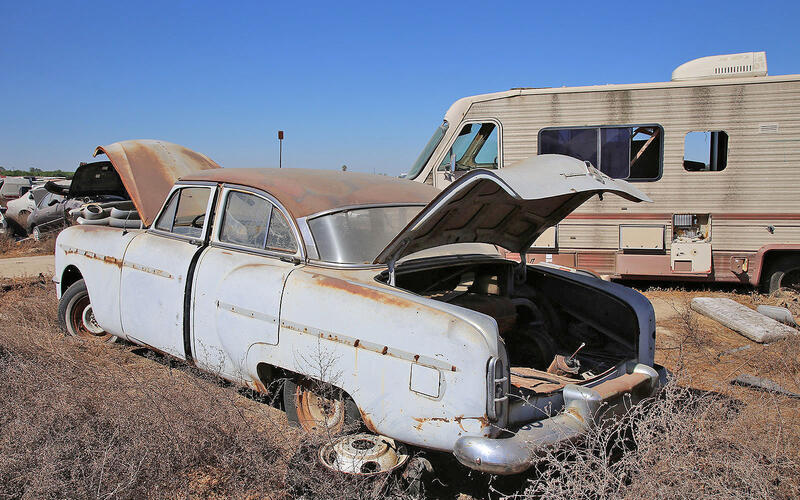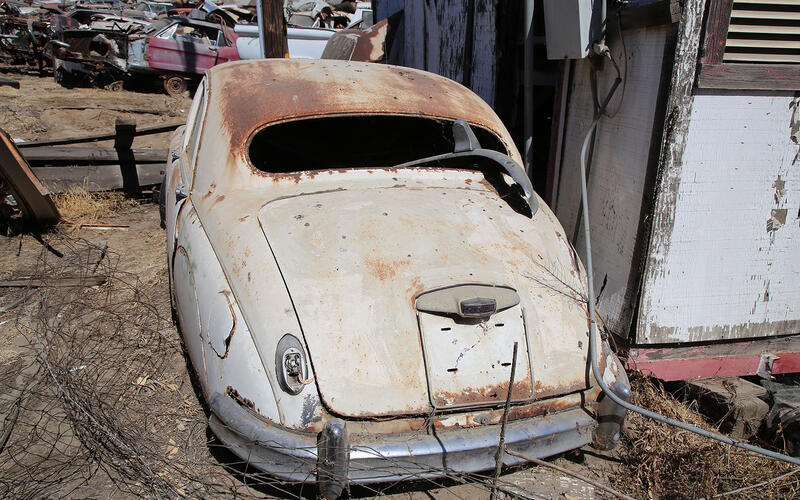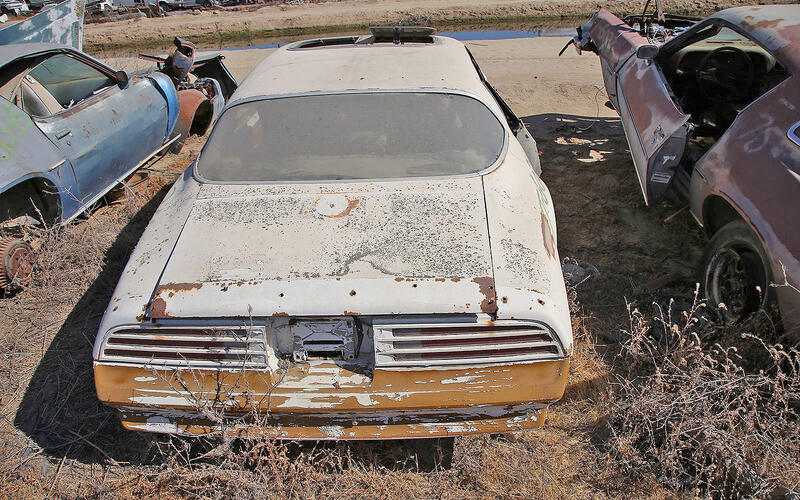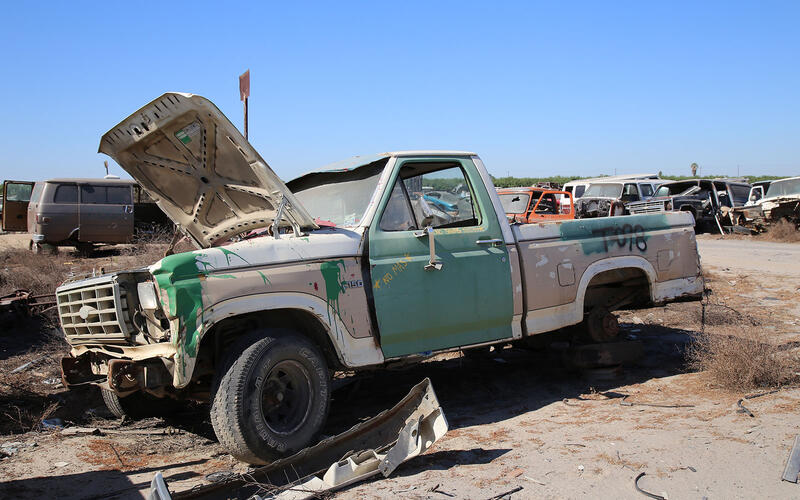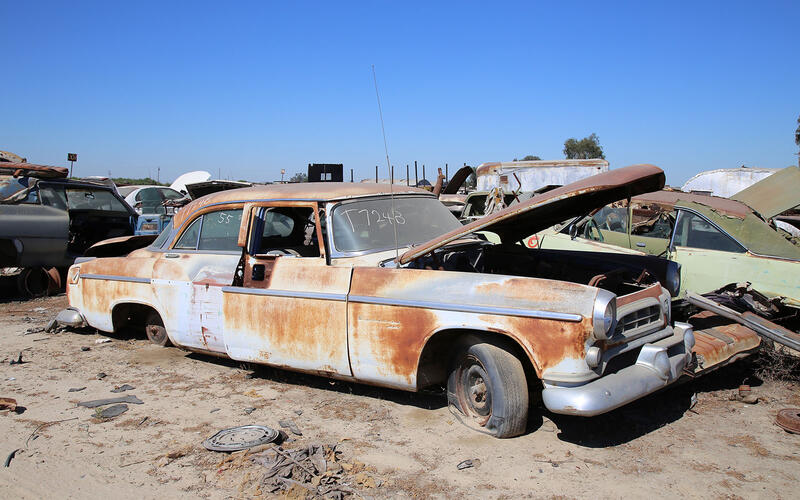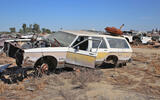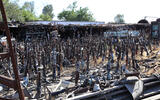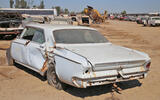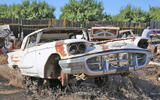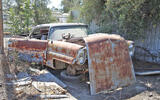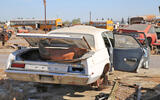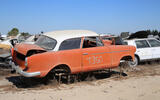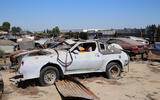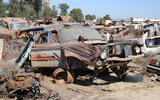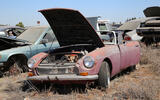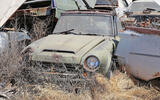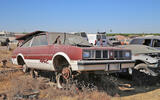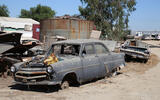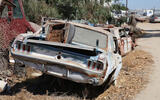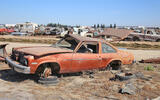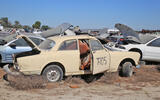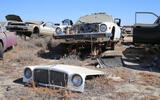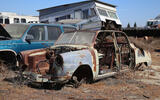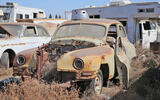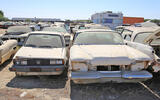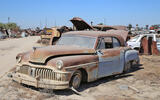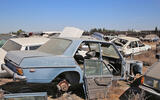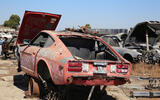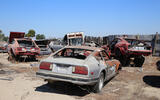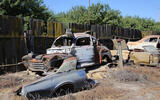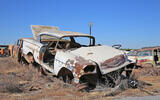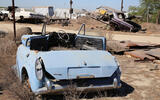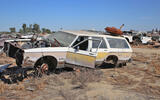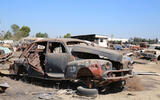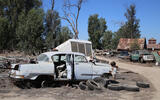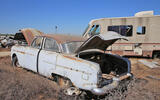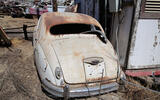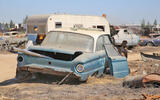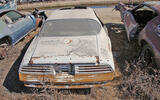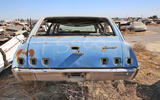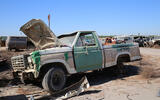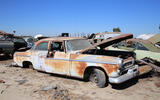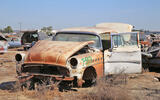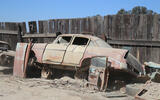 Slide of
Slide of
Turner’s Auto Wrecking of Fresno, California, is one of the last great salvage yards in the US.
With an estimated 10,000 cars spread over 70 acres of land, there’s something here for every classic car enthusiast. It’s no wonder parts hunters from all over the US and further afield, flock to this incredible place.
 Slide of
Slide of
The yard
We have already taken a look at the yard’s private lot, where most of the rarer project cars are stored, and now it’s time to take a whistle-stop tour of the main yard, which houses mainly parts vehicles. This is the only salvage yard we’ve been to that has a canal running through the middle of it.
Turner’s Auto Wrecking was founded in 1960, and in the 60-plus years that it’s been in business it has amassed a huge collection of rare spare parts. In addition to barns full of engines and transmissions, there are acres of treasures stored outside. We saw vast piles of grilles, exhaust manifolds, hoods, wheel hubs, radiators, windshields and rear axles. One of the stranger sights was this forest of steering columns, which seems to be thriving in the Californian climate… (pictured). We have no doubts that yard owner Jerry, who is in his mid 90s, knows exactly what everything is:
 Slide of
Slide of
CHRYSLER NEWYORKER - 1964
Having suffered a serious collision, this Chrysler New Yorker four-door hardtop has found its final resting place in Turner’s Auto Wrecking, where time and scavengers are slowly picking it apart. Stripped of its V8 engine and much of its front end, this once proud beauty faces an uncertain fate. The '62' scribbled on the front door adds a touch of confusion, as it’s actually a 1964 car.
 Slide of
Slide of
FORD THUNDERBIRD - 1960
This 1960 Ford Thunderbird looks like it’s about to take off, when in truth its flying days are well and truly behind it. The second generation ‘Square Birds’ (1958-1960) were vastly bigger than their predecessors, and of course featured a second row of seats.
Demand soared as a consequence, with close to 200,000 finding buyers. The 1960 cars accounted for almost half of these sales.
 Slide of
Slide of
LINCOLN PREMIER - 1957
The Lincoln Premier, produced from 1956 to 1960, epitomized luxury as an upscale sibling to the Capri. Sporting its distinctive stacked headlights, this 1957 two-door hardtop charmed over 15,000 buyers, and today, well-preserved specimens command serious cash. While this sorry example falls somewhat short of perfection, it still holds potential as a treasure trove of valuable spare parts.
 Slide of
Slide of
FORD CUSTOM - 1971
In 1971, when this Custom 500 rolled off the line, Ford was market leader. It achieved over 2 million sales, trumping rival Chevrolet by close to 200,000 units. But its reign would come to an end the following year, and Ford wouldn’t take the top spot again until 1988.
 Slide of
Slide of
RAMBLER SUPER-AMERICAN - 1959
We’re amazed at how many Rambler Super Americans still turn up in salvage yards – and more often than not in this color. That said, they don’t often look as good as this 1959 two-door. The bodywork is in superb condition, and we’re struggling to understand how it ended up here in the first place.
Built between 1958 and 1969, the Rambler American was frequently the most budget-friendly car in the US, a popular buy for the burgeoning ‘second car’ market.
 Slide of
Slide of
FORD PINTO - 1974
It’s not often that you find a DeLorean in a junkyard – in fact we never have… What we have here is someone’s misguided endeavor to fashion a Back to the Future DeLorean time machine out of a 1974 Ford Pinto.
So, if anyone is on the lookout for a used Ford flux capacitor, then they’ll want to head to Turner’s Auto Wrecking…
 Slide of
Slide of
MERCURY METEOR - 1963
A lot of the cars in this yard are in a poor state, having been well and truly picked over by parts hunters. That said, this collision damaged 1963 Mercury Meteor probably wouldn’t have looked too good on the day it arrived at Turner’s Auto Wrecking.
Built between 1961 and 1963, the Meteor was a base trim, full size sedan. Like its smaller Comet sibling, it was named at a time when the public were fascinated by the space race.
 Slide of
Slide of
MG MGB
This 1960s MG MGB hails from the car’s golden era, before its external appearance was arguably ruined by the addition first side marker lights and then rubber bumpers. Built between 1962 and 1980, the stylish, affordable and uncomplicated MGB quickly became the world’s best-selling sportscar. In fact it held this title for decades, finally losing it to the Mazda Miata.
 Slide of
Slide of
DATSUN 1600
This little Datsun 1600 is dwarfed by the US iron surrounding it. Although a bit bruised and battered, it’s relatively complete, and a restoration wouldn’t be beyond the realms of possibility.
The roadster, which was the predecessor of the Z-car, was designed to compete directly with European manufacturers like Fiat, MG and Triumph.
 Slide of
Slide of
OLDSMOBILE 442 AEROBACK - 1979
Built from 1964 to 1987, the Oldsmobile 4-4-2 derived its name from its defining features: a four-barrel carburetor, four-speed manual gearbox, and twin exhausts. The fourth-generation models, like this 1979 Aeroback, were built upon the sturdy foundation of the A-body Cutlass. Once a common sight in US salvage yards, they’re now few and far between.
 Slide of
Slide of
FORD - 1952
Although its highway cruising days are definitely behind it, plenty of its hard-to-find parts are likely to live to see another day. There’s plenty up for grabs, including a pair of 1954 taillights (according to the scribbling on the rear fenders). Ford introduced a one-piece windshield in 1952, but this one has Although its highway cruising days are definitely behind it, plenty of its hard-to-find parts are likely to live to see another day. There’s plenty up for grabs, including a pair of 1954 taillights (according to the scribbling on the rear fenders). Ford introduced a one-piece windshield in 1952, but this one has long-since disappeared.
 Slide of
Slide of
FORD MUSTANG - 1967
First generation Mustangs sold like hot cakes. In 1965 some 559,500 found buyers, and volumes increased to an all-time high of 607,568 (a cool 2250 per every working day) the following year. The hype started to die down by 1967, when this example rolled off the line, and sales dropped by 22% to 472,121. Demand would continue to decline until the arrival of the second generation in 1974.
Incidentally, the worst-selling Mustangs so far are the sixth-generation cars, which managed just 662,952 sales between 2015 and 2023.
 Slide of
Slide of
CHEVROLET NOVA - 1976
A badly distorted 1976 Chevrolet Nova shows off its hatchback, which was still a bit of a novelty in the mid-1970s. Although Citroen claims to have developed the world’s first hatchback, with its 1938 11CV Commerciale, the car that brought the concept to the masses was the 1965 Renault 16.
 Slide of
Slide of
VOLVO AMAZON
In the mid-1950s, Swedish car manufacturer Volvo set its sights on the lucrative US market. The first cars to land in the Port of Los Angeles were the PV444s. Although sales were initially slow, by 1960 some 50,000 of them had found customers. However, it was its successor, the Amazon (like the two-door sedan seen here) that achieved serious sales volumes. Today Volvo frequently sells more than 100,000 cars in the US annually.
 Slide of
Slide of
JAGUAR XJ SERIES 3
Series 3 Jaguar XJs suffered from corrosion, especially in the Salt Belt, where gritted winter roads played havoc with their undersides. But check out the sills on this example, which are almost as good as the day it rolled off the line.
This is of course has a lot more to do with California’s favourable climate than Jag build quality. On average Fresno gets 300 days of sunshine a year, and 11.5in of rainfall (compared with a national average of 38in).
 Slide of
Slide of
STUDEBAKER COMMANDER - 1947
Having been stripped of most of its useful parts, including its roof, it’s probably about time that this 1947 Studebaker Commander four-door is put out of its misery and crushed. But before it is, you can be sure that the yard will remove everything left that’s salvageable. Turner’s Auto Wrecking has barns full of hard-to-find parts that have been removed from cars over the decades.
 Slide of
Slide of
PACKARD - 1949
The Packard Motor Car Company was founded in 1899, and quickly developed a reputation for building prestigious automobiles. It was also an innovator, and is credited for developing the modern steering wheel, and for being the first company to put air conditioning in a car back in 1940.
The brand’s glory days were the 1920s, and by 1949 when this example was built, it was seriously beginning to struggle against the Big Three. It merged with Studebaker in 1953, and was phased out by the end of the decade.
 Slide of
Slide of
IMPERIAL - 1959
During our pre-Covid visit we discovered that Turners Auto Wrecking had more than its fair share of Imperials. That said, we have heard rumors that they have all since been destroyed.
At 226in long, and 81in wide, the 1959 Imperial was a real automotive giant. And for a sense of scale, there’s a 1980s Volkswagen next door.
 Slide of
Slide of
DESOTO CUSTOM SPORTSMAN - 1950
The 1950 Desoto Custom Sportsman pillarless coupe is one of a mere 4,600 units sold. Considering the passage of time, only a small fraction of these have survived, and it’s the only one we have stumbled upon in a salvage yard.
Equipped with a six-cylinder 3.9-litre engine, the car boasted a top speed of 83mph and a 0-60mph acceleration time of 23.4secs.
 Slide of
Slide of
MERCEDES W114 250
We wonder why someone went to the bother of removing this Mercedes-Benz W114’s door, and then changed their minds. Although the car was offered in the US with a diesel engine, this well picked over example is a 250, which means it was once powered by six-cylinder gasoline engine.
Manufactured between 1968 and 1976, these cars developed a fantastic reputation for reliability and longevity, often notching up inter-galactic mileages when in taxi service.
 Slide of
Slide of
DATSUN 260Z - 1974
Although it’s not the best organised yard we’ve ever visited, we did find a whole corner devoted to Datsun/Nissan Z-cars – including this 1974 260Z. The Z-cars were designed to be direct competitors to the MG, and with considerably higher top speeds, better acceleration and attractive looks to boot, it’s no wonder that they were soon outselling them.
In fact these cars did wonders for the Japanese car industry’s image as a whole.
 Slide of
Slide of
NISSAN 280ZX
This Nissan 280ZX has been badly fire damaged, but still has some very useful parts to offer. The 280ZX was a completely new design, with only the six-cylinder engine and other driveline components being carried over from the 280Z.
The manufacturer was in the process of rebranding at the time, and this car would have worn ‘Datsun by Nissan’ badges.
 Slide of
Slide of
FORD - 1947
This 1947 Ford coupe has definitely seen better days. That said, it’s fared considerably better than what appears to be the remains of the 1967/1968 Mercury Cougar next to it.
Scribbled faintly on its door are the words ‘little duce coup’. Of course a real deuce coupe is a 1932 Ford coupe, which is widely considered to be the definitive hot rod.
 Slide of
Slide of
CHEVROLET CORVETTE - 1988
This was one of three similarly aged Chevrolet Corvettes we saw at Turner’s Auto Wrecking. According to the writing on the door it’s a 1988 model, making it one of the newer cars in stock.
The yard actually has cars dating back as far as the 1920s, but the bulk of the vehicles we saw were from the 1960s and 1970s.
 Slide of
Slide of
CHEVROLET IMPALA - 1958
Named after a graceful African antelope, this Chevrolet Impala looks like it’s been hunted down and torn apart by a pride of hungry lions… It’s a two-door hardtop, and was built in 1958, the Impala’s debut year.
One of the car’s most significant features was its quad headlamps, the remains of which can be seen on the ground. It was a styling trend that quickly spread across the industry.
 Slide of
Slide of
AUSTIN AMERICA
The Austin 1100/1300, and its MG, Morris, Riley, Vanden Plas and Wolseley siblings might have been huge sellers in their native United Kingdom, but it was a different story in the US. And that was despite calling the car America.
Although it was supposed to compete with the VW Bug, it sold a lot less, with an estimated 60,000 finding buyers during the five years it was available (1968-1972). This roofless example, which has been cut into two pieces, was fitted with a four-speed automatic transmission.
 Slide of
Slide of
OLDSMOBILE CUSTOM CRUISER - 1985
Oldsmobile produced 451,819 Custom Cruiser full-size station wagons over the model’s 21-year (1971 to 1992) lifespan. Based on GM’s B-platform, this is a second generation car. It’s one of 22,889 to roll off the line in 1985, and features the model’s popular woodgrain external trim. While the majority were specified with a 5-litre V8 gasoline engine, a 5.7-litre diesel engine was also offered. The 0-60mph acceleration times were 14.5sec and 20.4sec respectively.
 Slide of
Slide of
LINCOLN - 1946
1946 Lincolns aren’t the prettiest cars ever built, and the missing dental work on this example further accentuates its challenged visual appeal. It’s one of just 16,645 Lincolns built that year, which made it the 16th most popular brand in the US. At the time it was outsold two-to-one by both luxury rivals Cadillac and Packard, both quicker to get back on the horse after the end of the second world war.
 Slide of
Slide of
DESOTO FIREDOME - 1953
1953 was DeSoto’s silver anniversary year, and its second best on record in terms of vehicle sales. Of the 132,104 built, almost half were four-door Firedomes like this. The car was powered by a 4.5-litre V8, which kicked-out 160hp, and took the car to 60mph in 12.8sec. Downhill with a tailwind it could almost manage 100mph.
 Slide of
Slide of
PACKARD CLIPPER - 1953
Look at this 1953 Packard Clipper four-door sedan’s rust-free, and relatively straight body panels. It’s no wonder that Turner’s Auto Wrecking is so popular with parts hunters.
Nearly 90,000 Packards were produced in 1953, making it America’s 14th largest auto manufacturer by volume.
 Slide of
Slide of
JAGUAR - MK1
Once a timeless symbol of automotive sophistication, this Jaguar MK1 (1955 - 1959) no longer exudes the grace and power it was once famed for.
This rare, relatively rust-free example, appears to be one of the 17,405 3.4-litre cars built predominantly for the US market. Meanwhile most domestic examples had 2.4-litre lumps under their hoods.
 Slide of
Slide of
FORD FALCON - 1960
The Falcon, which was a scaled down version of the Galaxie, was Ford’s first compact car. It was designed to compete with the growing number of smaller European and Japanese imports.
This is a 1960 car, the first year in the model’s decade-long production run. The bodywork is exceptionally straight and rust-free, and amazingly it has even retained all of its glass. What a shame it was stripped for spares as it could have made a great project car for someone.
 Slide of
Slide of
PONTIAC FIREBIRD - 1978
This 1978 Pontiac Firebird is perched on the banks of the Washington Canal, an irrigation channel that runs right through the heart of Turner’s Auto Wrecking.
Perhaps whoever fitted this aftermarket sunroof should have bought themselves a Targa-top car instead. We counted well over a dozen second generation (1970 to 1981) Firebirds in the yard.
 Slide of
Slide of
CHEVROLET IMPALA - 1968
Once a cherished travel companion for vacations, and now a silent witness to forgotten memories. Just think of all the family roadtrips this 1968 Chevy Impala station wagon would have taken - mom and dad fretting over spilled sodas and milkshakes, and kids continually asking “are we nearly there yet?”
 Slide of
Slide of
FORD F150
We wonder how somebody managed to spill paint all over this mid-1980s Ford F150 truck’s front fender. More to the point, why has someone scribbled “NO SAVAS NADA’ on its door, which according to Google Translate, is Spanish for “you don’t know anything”. What we do know is that this retired workhorse’s days are numbered.
 Slide of
Slide of
CHRYSLER WINDSOR - 1955
Under this 1955 Chrysler Windsor Deluxe’s open hood once sat a 4.9-litre V8, which would have propelled the car to 60mph in a respectable time of 11.8sec.
Close to 100,000 of these were built, with the vast majority being four-door sedans like this.
Like all the other Chryslers built that year, it was penned by legendary designer Virgil Exner.
 Slide of
Slide of
BUICK ROADMASTER - 1955
Someone has scribbled ‘NO ENG’ on the windshield of this 1955 Buick Roadmaster. But while it’s lacking its Fireball V8, what it does have is an abundance of decent body panels.
1955 was a great year for Buick, which achieved 738,814 sales, a figure it wouldn’t beat until the late 1970s. It would register 31,717 of these four-door sedans.
 Slide of
Slide of
CHEVROLET 210 - 1956
In 1956 Chevrolet offered no less than 18 different models, which together added up to sales of roughly 1.6 million units. While rarest of the bunch was the Bel Air two-door Nomad Wagon, the best sellers were 210 four-door sedans like this. In total some 298,935 people drove one out of the showrooms. We found this nice example tucked away in a corner of the yard.
Access control:
Open
Include in Apple News:


